Regionalization of a Landscape-Based Hazard Index of Malaria Transmission: An Example of the State of Amapá, Brazil
Abstract
:1. Introduction
2. Materials and Methods
2.1. Assessing the Effect of a Coarser Spatial Resolution on NLHI Values
2.2. Large-Scale Implementation of NLHI
2.2.1. Input Data: TerraClass© product
2.2.2. Large-Scale NLHI Implementation
3. Results
3.1. Within-Sensor Comparison between NLHIsim and NLHIval
3.2. Relationship between NLHI Values and Malaria Incidence Rates
3.3. Large-Scale NLHI
4. Discussion
5. Conclusions
Acknowledgments
Author Contributions
Conflicts of Interest
Abbreviations
| ED | Edge density |
| EMBRAPA | Brazilian Agricultural Research Corporation |
| HPC | High Performance Computing |
| INPE | Brazilian National Institutes for Space Research |
| JAXA | Japan Aerospace Exploitation Agency |
| LULC | Land use and land cover |
| NLHI | Normalization landscape-based hazard index |
| pF | Proportion of the forest |
| RAM | Random Access Memory |
| SAR | Synthetic aperture radar |
References
- WHO. World Malaria Repport 2016; WHO: Geneva, Swizerland, 2016. [Google Scholar]
- Vitor-Silva, S.; Siqueira, A.M.; de Souza Sampaio, V.; Guinovart, C.; Reyes-Lecca, R.C.; de Melo, G.C.; Monteiro, W.M.; Del Portillo, H.A.; Alonso, P.; Bassat, Q.; et al. Declining malaria transmission in rural Amazon: Changing epidemiology and challenges to achieve elimination. Malar. J. 2016, 15, 266. [Google Scholar] [CrossRef] [PubMed]
- Alimi, T.O.; Fuller, D.O.; Quinones, M.L.; Xue, R.D.; Herrera, S.V.; Arevalo-Herrera, M.; Ulrich, J.N.; Qualls, W.A.; Beier, J.C. Prospects and recommendations for risk mapping to improve strategies for effective malaria vector control interventions in latin America. Malar. J. 2015, 14, 519. [Google Scholar] [CrossRef] [PubMed]
- Alegana, V.A.; Atkinson, P.M.; Lourenco, C.; Ruktanonchai, N.W.; Bosco, C.; Erbach-Schoenberg, E.Z.; Didier, B.; Pindolia, D.; Le Menach, A.; Katokele, S.; et al. Advances in mapping malaria for elimination: Fine resolution modelling of plasmodium falciparum incidence. Sci. Rep. 2016, 6, 29628. [Google Scholar] [CrossRef] [PubMed]
- Ye, Y.; Hoshen, M.; Kyobutungi, C.; Louis, V.R.; Sauerborn, R. Local scale prediction of plasmodium falciparum malaria transmission in an endemic region using temperature and rainfall. Glob. Health Action 2009, 2. [Google Scholar] [CrossRef]
- Musset, L.; Pelleau, S.; Girod, R.; Ardillon, V.; Carvalho, L.; Dusfour, I.; Gomes, M.S.M.; Djossou, F.; Legrand, E. Malaria on the Guiana shield: A review of the situation in French Guiana. Mem. Inst. Oswaldo Cruz 2014, 109, 525–533. [Google Scholar] [CrossRef] [PubMed]
- Vittor, A.Y.; Gilman, R.H.; Tielsch, J.; Glass, G.; Shields, T.; Lozano, W.S.; Pinedo-Cancino, V.; Patz, J.A. The effect of deforestation on the human-biting rate of Anopheles darlingi, the primary vector of Falciparum malaria in the Peruvian Amazon. Am. J. Trop. Med. Hyg. 2006, 74, 3–11. [Google Scholar] [PubMed]
- Vittor, A.Y.; Pan, W.; Gilman, R.H.; Tielsch, J.; Glass, G.; Shields, T.; Sanchez-Lozano, W.; Pinedo, V.V.; Salas-Cobos, E.; Flores, S.; et al. Linking deforestation to malaria in the Amazon: Characterization of the breeding habitat of the principal malaria vector, Anopheles darlingi. Am. J. Trop. Med. Hyg. 2009, 81, 5–12. [Google Scholar] [PubMed]
- Barros, F.S.; Honorio, N.A. Deforestation and malaria on the Amazon frontier: Larval clustering of Anopheles darlingi (Diptera: Culicidae) determines focal distribution of malaria. Am. J. Trop. Med. Hyg. 2015, 93, 939–953. [Google Scholar] [CrossRef] [PubMed]
- Stefani, A.; Dusfour, I.; Cruz, M.C.B.; Dessay, N.; Galardo, A.K.R.; Galardo, C.D.; Girod, R.; Gomes, M.S.M.; Gurgel, H.; Lima, A.C.F.; et al. Land cover, land use and malaria in the amazon: A systematic literature review of studies using remotely sensed data. Malar. J. 2013, 12. [Google Scholar] [CrossRef] [PubMed]
- Li, Z.; Roux, E.; Dessay, N.; Girod, R.; Stefani, A.; Nacher, M.; Moiret, A.; Seyler, F. Mapping a knowledge-based malaria hazard index related to landscape using remote sensing: Application to the cross-border area between French Guiana and Brazil. Remote Sens. 2016, 8, 319. [Google Scholar] [CrossRef]
- Lu, D.; Batistella, M.; Li, G.; Moran, E.; Hetrick, S.; Freitas, C.D.; Dutra, L.V.; Sant’anna, S.J. Land use/cover classification in the Brazilian Amazon using satellite images. Pesq. agropec. bras. 2012, 47. [Google Scholar] [CrossRef] [PubMed]
- Wang, G.; Liu, J.; He, G. A method of spatial mapping and reclassification for high-spatial-resolution remote sensing image classification. Sci. World J. 2013, 2013, 192982. [Google Scholar] [CrossRef] [PubMed]
- Asner, G.P. Cloud cover in Landsat observations of the Brazilian Amazon. Int. J. Remote Sens. 2001, 22, 3855–3862. [Google Scholar] [CrossRef]
- Souza, J.C.; Siqueira, J.; Sales, M.; Fonseca, A.; Ribeiro, J.; Numata, I.; Cochrane, M.; Barber, C.; Roberts, D.; Barlow, J. Ten-year Landsat classification of deforestation and forest degradation in the Brazilian Amazon. Remote Sens. 2013, 5, 5493–5513. [Google Scholar] [CrossRef]
- Tiner, R.W.; Lang, M.W.; Klemas, V.V. Remote Sensing of Wetlands: Applications and Advances; CRC Press: Boca Raton, FL, USA, 2015. [Google Scholar]
- Powell, S.L.; Pflugmacher, D.; Kirschbaum, A.A.; Kim, Y.; Cohen, W. Moderate resolution remote sensing alternatives: A review of Landsat-like sensors and their applications. J. Appl. Remote Sens. 2007, 1, 012506. [Google Scholar]
- Gong, P.; Wang, J.; Yu, L.; Zhao, Y.; Zhao, Y.; Liang, L.; Niu, Z.; Huang, X.; Fu, H.; Liu, S.; et al. Finer resolution observation and monitoring of global land cover: First mapping results with Landsat TM and ETM+ data. Int. J. Remote Sens. 2013, 34, 2607–2654. [Google Scholar] [CrossRef]
- Baraldi, A.; Puzzolo, V.; Blonda, P.; Bruzzone, L.; Tarantino, C. Automatic spectral rule-based preliminary mapping of calibrated Landsat tm and etm+ images. IEEE Trans. Geosci. Remote Sens. 2006, 44, 2563–2586. [Google Scholar] [CrossRef]
- Kim, D.H.; Sexton, J.O.; Noojipady, P.; Huang, C.Q.; Anand, A.; Channan, S.; Feng, M.; Townshend, J.R. Global, Landsat-based forest-cover change from 1990 to 2000. Remote Sens. Environ. 2014, 155, 178–193. [Google Scholar] [CrossRef]
- Song, D.-X.; Huang, C.; Sexton, J.O.; Channan, S.; Feng, M.; Townshend, J.R. Use of Landsat and corona data for mapping forest cover change from the mid-1960s to 2000s: Case studies from the eastern united states and central brazil. ISPRS 2015, 103, 81–92. [Google Scholar] [CrossRef]
- Almeida, C.A.D.; Coutinho, A.C.; Esquerdo, J.C.D.M.; Adami, M.; Venturieri, A.; Diniz, C.G.; Dessay, N.; Durieux, L.; Gomes, A.R. High spatial resolution land use and land cover mapping of the brazilian legal amazon in 2008 using Landsat-5/TM and modis data. Acta Amazon. 2016, 46, 291–302. [Google Scholar] [CrossRef]
- Hargis, C.D.; Bissonette, J.A.; David, J.L. The behavior of landscape metrics commonly used in the study of habitat fragmentation. Landsc. Ecol. 1998, 13, 167–186. [Google Scholar] [CrossRef]
- Saura, S. Effects of minimum mapping unit on land cover data spatial configuration and composition. Int. J. Remote Sens. 2002, 23, 4853–4880. [Google Scholar] [CrossRef]
- Frohn, R.; Hao, Y. Landscape metric performance in analyzing two decades of deforestation in the Amazon basin of rondonia, Brazil. Remote Sens. Environ. 2006, 100, 237–251. [Google Scholar] [CrossRef]
- McGarigal, K.; Cushman, S.; Ene, E. Fragstats v4: Spatial Pattern Analysis Program for Categorical and Continuous Maps; University of Massachusetts, Amherst: Amherst, MA, USA; Available online: https://www.umass.edu/landeco/research/fragstats/fragstats.html (accessed on 1 April 2017).
- Hustache, S.; Nacher, M.; Djossou, F.; Carme, B. Malaria risk factors in amerindian children in French Guiana. Am. J. Trop. Med. Hyg. 2007, 76, 619–625. [Google Scholar] [PubMed]
- Stefani, A.; Hanf, M.; Nacher, M.; Girod, R.; Carme, B. Environmental, entomological, socioeconomic and behavioural risk factors for malaria attacks in amerindian children of Camopi, French Guiana. Malar. J. 2011, 10. [Google Scholar] [CrossRef] [PubMed]
- Stefani, A.; Roux, E.; Fotsing, J.M.; Carme, B. Studying relationships between environment and malaria incidence in Camopi (French Guiana) through the objective selection of buffer-based landscape characterisations. Int. J. Health Geogr. 2011, 10. [Google Scholar] [CrossRef] [PubMed]
- Theau, J.; Sankey, T.T.; Weber, K.T. Multi-sensor analyses of vegetation indices in a semi-arid environment. Gisci. Remote Sens. 2010, 47, 260–275. [Google Scholar] [CrossRef]
- Thiel, C.; Drezet, P.; Weise, C.; Quegan, S.; Schmullius, C. Radar remote sensing for the delineation of forest cover maps and the detection of deforestation. Forestry 2006, 79, 589–597. [Google Scholar] [CrossRef]
- Rahman, M.M.; Sumantyo, J.T.S. Mapping tropical forest cover and deforestation using synthetic aperture radar (SAR) images. Appl. Geomat. 2010, 2, 113–121. [Google Scholar] [CrossRef]
- Kellndorfer, J.; Cartus, O.; Bishop, J.; Walker, W.; Holecz, F. Large scale mapping of forests and land cover with synthetic aperture radar data. In Land Applications of Radar Remote Sensing; Holecz, F., Pasquali, P., Milisavljevic, N., Closson, D., Eds.; InTech: London, UK, 2014. [Google Scholar]
- Shimada, M.; Itoh, T.; Motooka, T.; Watanabe, M.; Shiraishi, T.; Thapa, R.; Lucas, R. New global forest/non-forest maps from ALOS PALSAR data (2007–2010). Remote Sens. Environ. 2014, 155, 13–31. [Google Scholar] [CrossRef]
- Shimada, M.; Itoh, T.; Motooka, T.; Watanabe, M.; Thapa, R. High-resolution satellite radar for mapping changes in global forest cover. SPIE Sens. Meas. 2015. [Google Scholar] [CrossRef]
- Ningthoujam, R.; Tansey, K.; Balzter, H.; Morrison, K.; Johnson, S.; Gerard, F.; George, C.; Burbidge, G.; Doody, S.; Veck, N.; et al. Mapping forest cover and forest cover change with airborne s-band radar. Remote Sens. 2016, 8, 577. [Google Scholar] [CrossRef]
- Hahn, M.B.; Gangnon, R.E.; Barcellos, C.; Asner, G.P.; Patz, J.A. Influence of deforestation, logging, and fire on malaria in the Brazilian Amazon. PLoS ONE 2014, 9, e85725. [Google Scholar] [CrossRef] [PubMed]
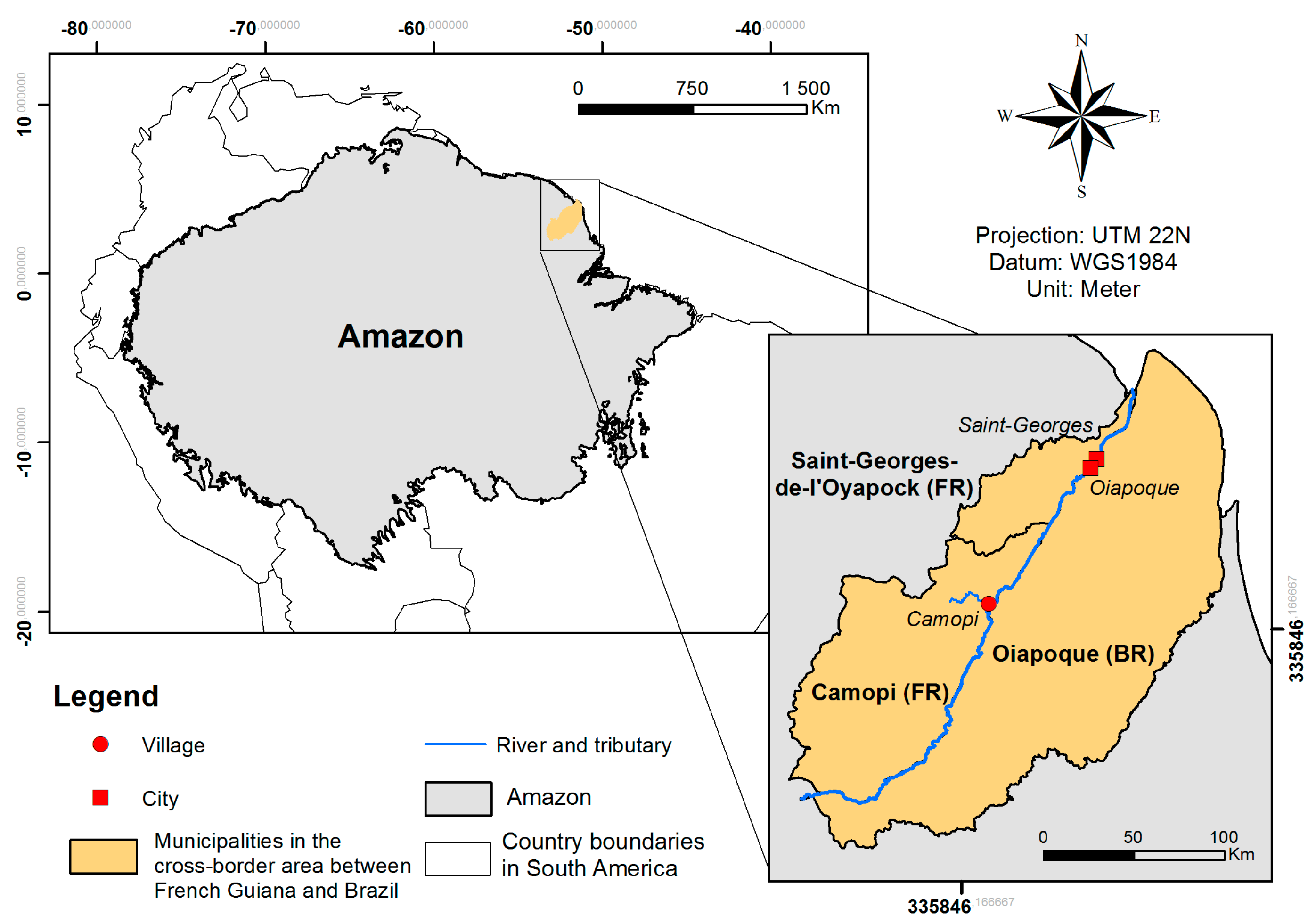
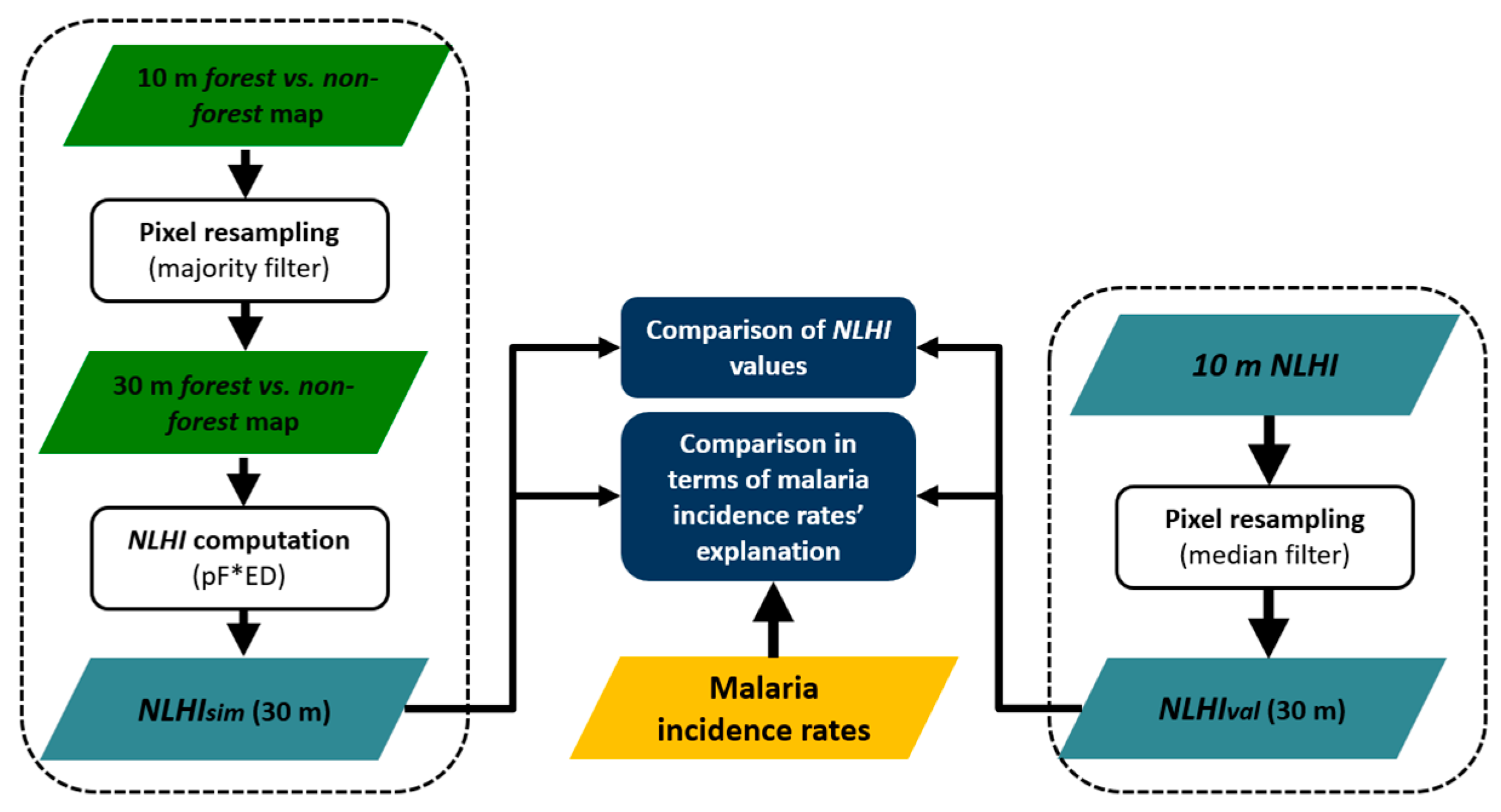
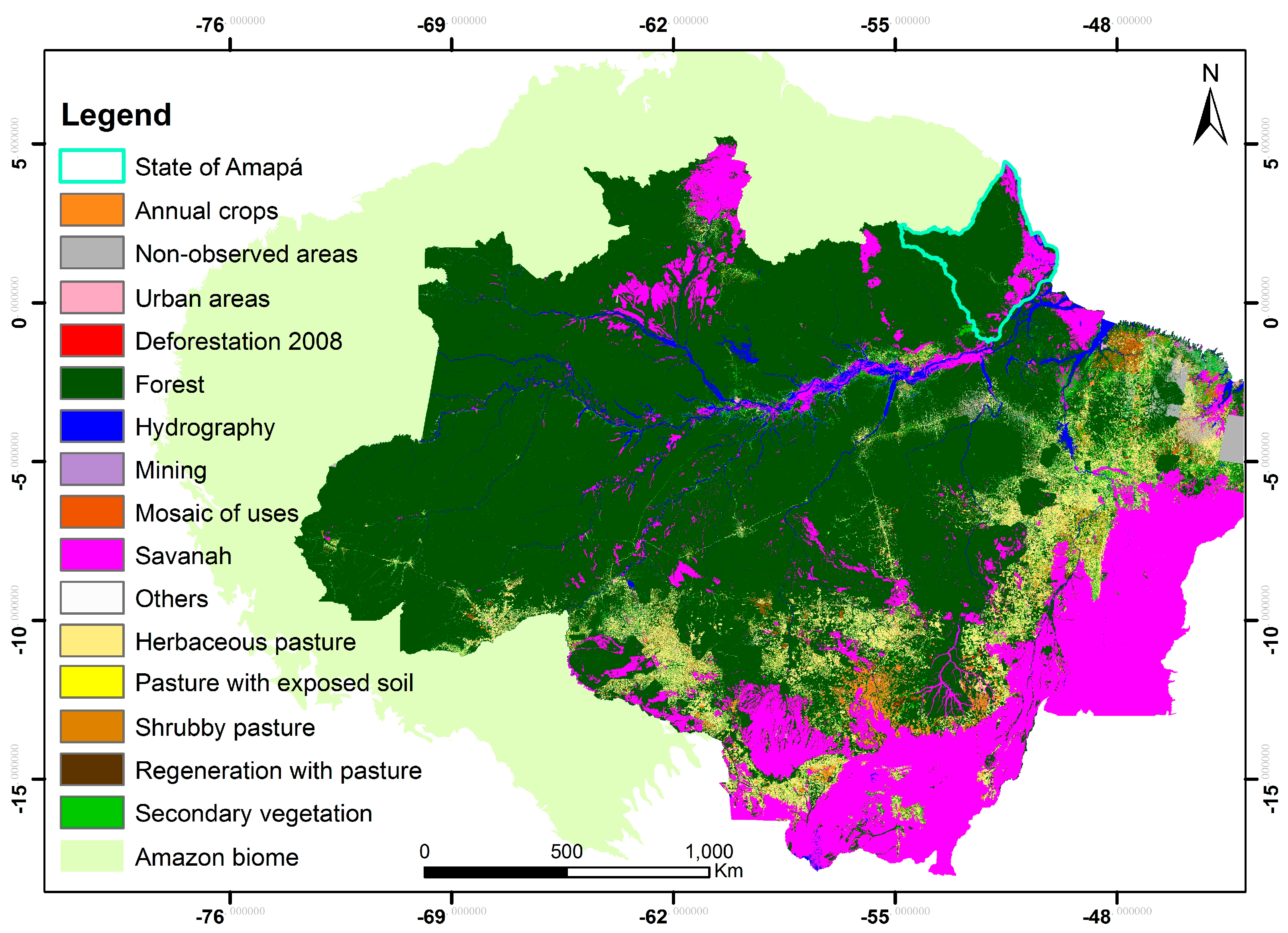
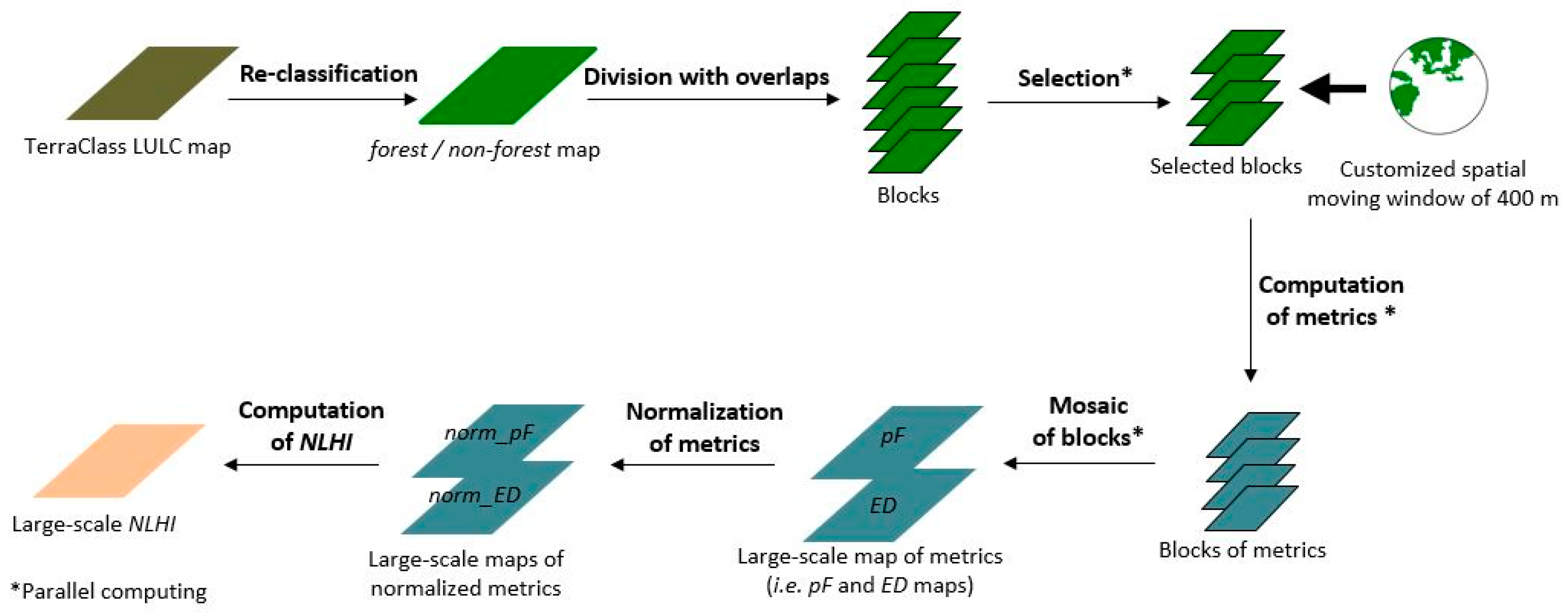
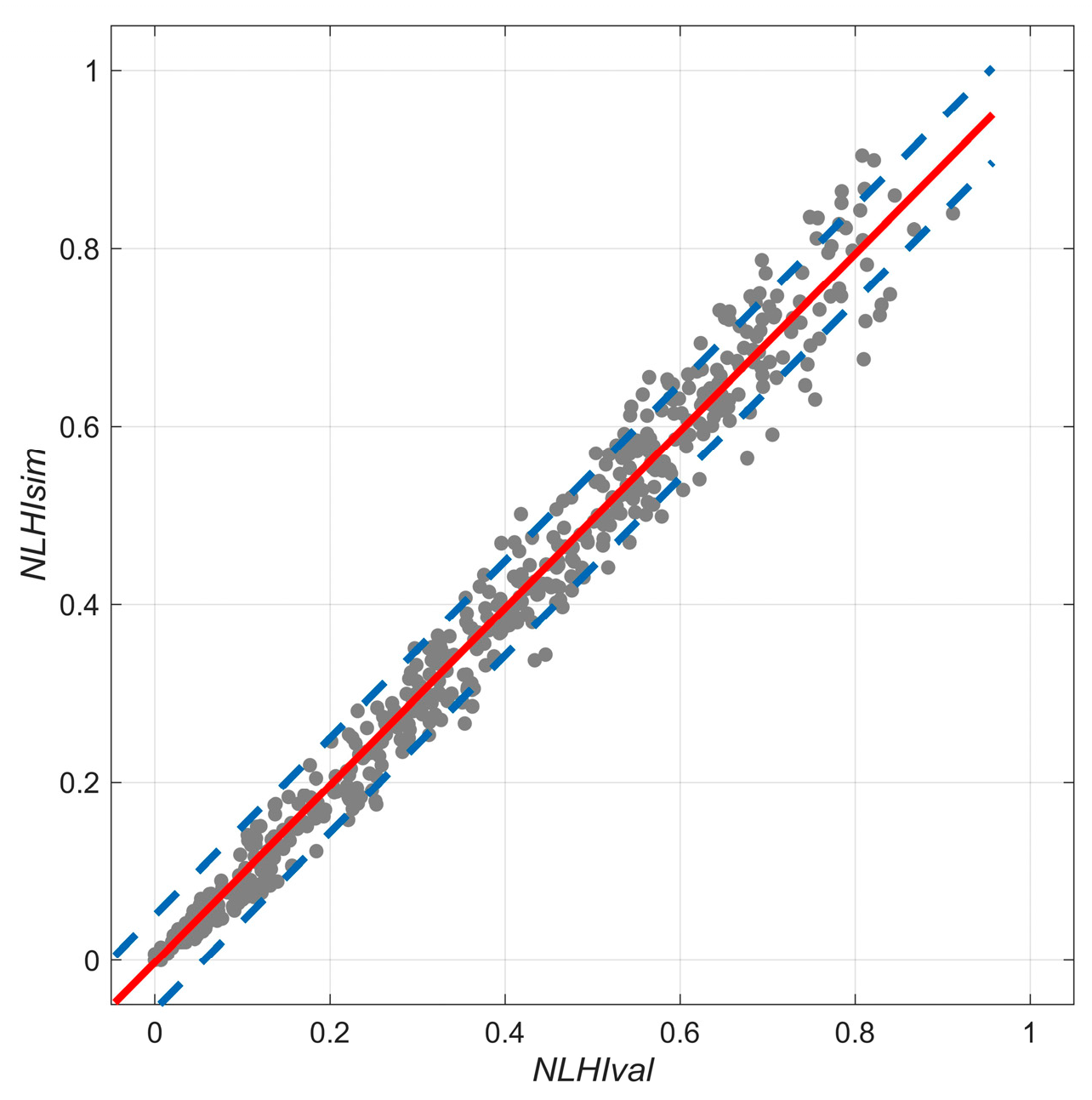
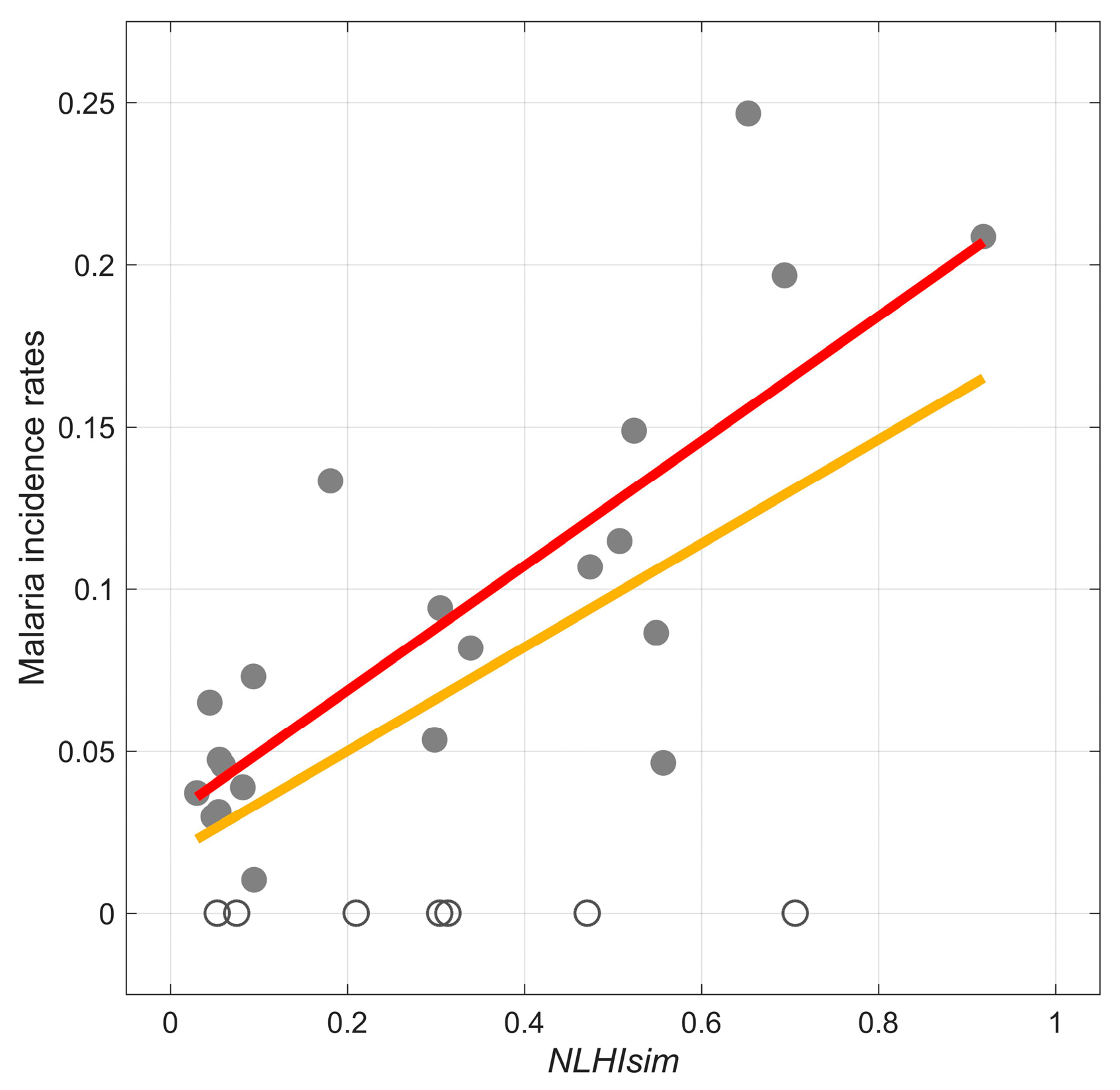
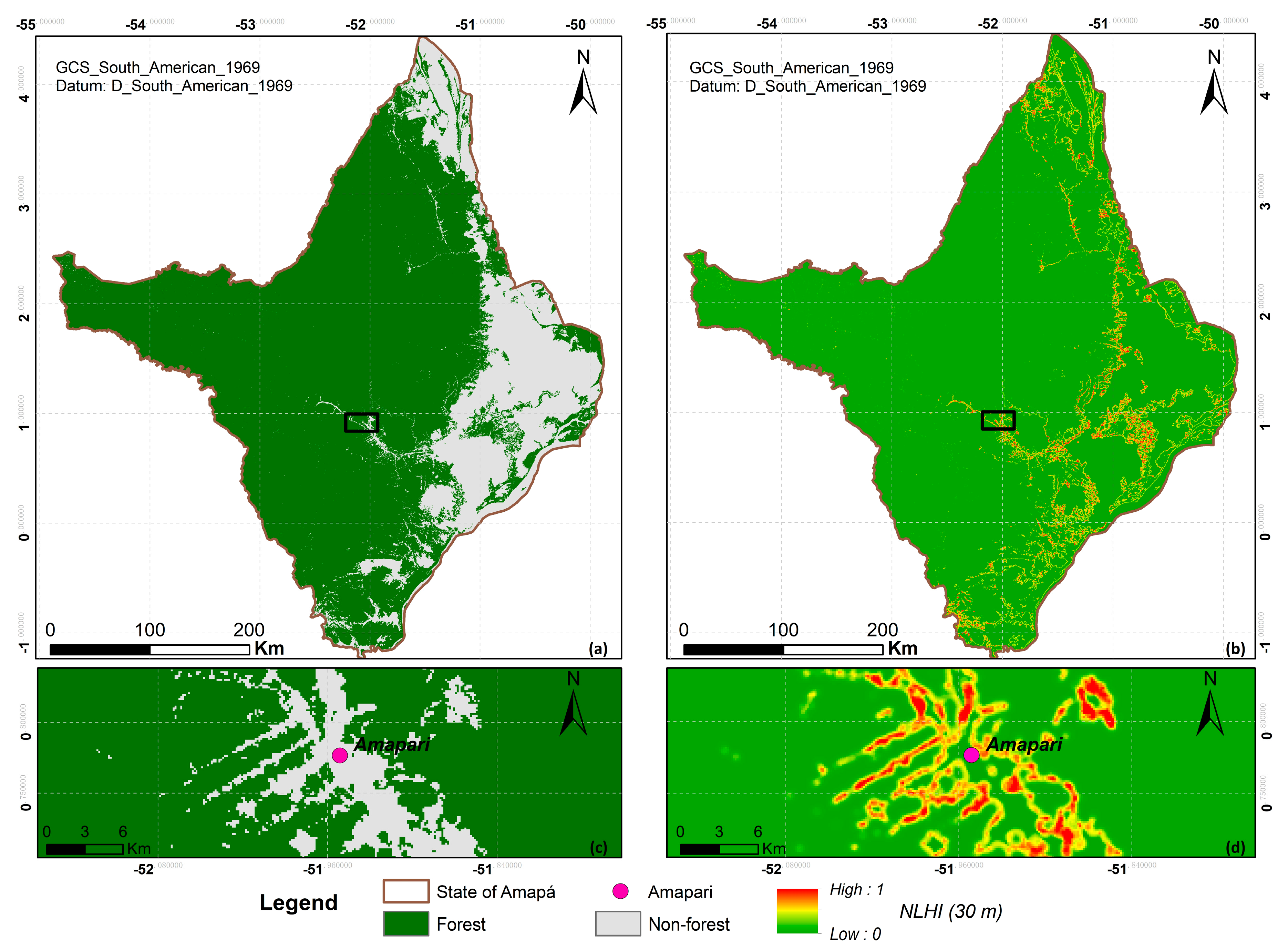
| Correlation Analysis | r | rho | R2 |
|---|---|---|---|
| Whole dataset | 0.60 ** | 0.44 | 0.36 ** |
| 0.59 ** | 0.43 | 0.35 ** | |
| Non-null incidence rates only | 0.80 ** | 0.76 ** | 0.64 ** |
| 0.79 ** | 0.75 ** | 0.63 ** |
© 2017 by the authors. Licensee MDPI, Basel, Switzerland. This article is an open access article distributed under the terms and conditions of the Creative Commons Attribution (CC BY) license (http://creativecommons.org/licenses/by/4.0/).
Share and Cite
Li, Z.; Catry, T.; Dessay, N.; Da Costa Gurgel, H.; Aparecido de Almeida, C.; Barcellos, C.; Roux, E. Regionalization of a Landscape-Based Hazard Index of Malaria Transmission: An Example of the State of Amapá, Brazil. Data 2017, 2, 37. https://doi.org/10.3390/data2040037
Li Z, Catry T, Dessay N, Da Costa Gurgel H, Aparecido de Almeida C, Barcellos C, Roux E. Regionalization of a Landscape-Based Hazard Index of Malaria Transmission: An Example of the State of Amapá, Brazil. Data. 2017; 2(4):37. https://doi.org/10.3390/data2040037
Chicago/Turabian StyleLi, Zhichao, Thibault Catry, Nadine Dessay, Helen Da Costa Gurgel, Cláudio Aparecido de Almeida, Christovam Barcellos, and Emmanuel Roux. 2017. "Regionalization of a Landscape-Based Hazard Index of Malaria Transmission: An Example of the State of Amapá, Brazil" Data 2, no. 4: 37. https://doi.org/10.3390/data2040037
APA StyleLi, Z., Catry, T., Dessay, N., Da Costa Gurgel, H., Aparecido de Almeida, C., Barcellos, C., & Roux, E. (2017). Regionalization of a Landscape-Based Hazard Index of Malaria Transmission: An Example of the State of Amapá, Brazil. Data, 2(4), 37. https://doi.org/10.3390/data2040037






